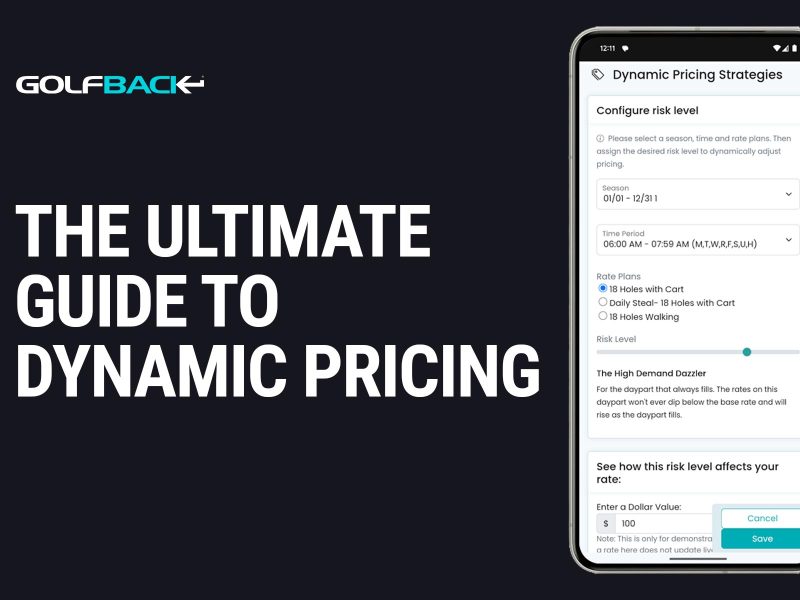Introduction
For years, golf courses have been using dynamic pricing, whether they realized it or not. Most courses naturally start with higher morning rates that decrease as the day progresses.
If your course has only one flat rate, you’re in the minority, and I’d wager a friendly $5 that at some point in your course’s history, that wasn’t always the case. (Don’t email me looking for $5 if you’re one of the rare exceptions!)
The difference today is that we now call it dynamic pricing.
Unfortunately, many golf operators associate the term with third-party platforms like GolfNow, which introduced “dynamic pricing” as a discounting tool to fill tee times—often at the expense of revenue optimization.
But real dynamic pricing isn’t about discounting, it’s about maximizing revenue. Just like airlines, hotels, and sports teams, golf courses can use demand-driven pricing to capture the maximum possible value for every tee time.
What is True Dynamic Pricing?
Dynamic pricing is part of an overall revenue management strategy that automatically adjusts tee time prices based on a variety of factors, including:
- Demand Trends – Adjust pricing based on real-time and historical booking patterns.
- Time of Day & Booking Windows – Optimize rates based on lead time and peak periods.
- Weather Conditions – Capitalize on ideal golf conditions or adjust for inclement weather.
- Last-Minute Availability – Increase prices when few tee times remain.
- Historical Pricing – Use past data to identify pricing opportunities.
- Known High-Demand Periods – Charge premium rates for holidays, weekends, and tournaments.
Instead of a one-size-fits-all approach, dynamic pricing allows courses to charge the right price, at the right time, for the right golfer.
If it’s 75°F, sunny, and only two tee times remain, those should sell at a premium—not at a discount. The real power of dynamic pricing is in raising rates when conditions are optimal, ensuring your course maximizes revenue instead of just lowering prices in hopes of filling tee times.
Common Misconceptions About Dynamic Pricing
Many operators hesitate to implement dynamic pricing because of misconceptions about how it works. Let’s clear up some of the biggest myths:
🛑 Myth: Dynamic pricing always lowers rates.
✅ Truth: Real dynamic pricing isn’t about discounting—it ensures high-demand tee times sell at premium prices while also filling lower-demand slots.
🛑 Myth: Dynamic pricing is confusing for golfers.
✅ Truth: Golfers are already familiar with dynamic pricing in airline tickets, hotels, and sports events. When communicated properly, it enhances their booking experience by offering fair market pricing.
🛑 Myth: My staff will spend too much time managing pricing.
✅ Truth: Automation tools like GolfBack’s Dynamic Pricing Slider remove the guesswork, allowing your team to focus on customer service, not spreadsheets.
How to Communicate Dynamic Pricing to Golfers
For dynamic pricing to be successful, it’s essential that golfers understand and accept the concept. The key to gaining their trust is positioning it in a way that highlights its benefits rather than making it seem like a complex or unpredictable pricing strategy.
Use the Right Language
Start by using the right language when explaining dynamic pricing. Instead of presenting it as a fluctuating or variable rate system, frame it as a way for golfers to get the best possible value based on demand. Just as airlines and hotels adjust their rates depending on availability and peak times, golf courses can use the same approach to offer fair and competitive pricing.
Encourage Early Bookers – (For most courses)
Encouraging early bookings is another effective way to help golfers see the value in dynamic pricing. Just like travelers who book flights or hotel rooms in advance to secure the best deals, golfers can take advantage of lower rates by reserving tee times early. By emphasizing this benefit, your course can drive more advance bookings while ensuring that golfers feel they have control over what they pay.
Be Transparent
Transparency is also crucial. Displaying rate fluctuations on your website and educating golfers about how the system works will help build trust. Instead of surprising golfers with price changes, make sure they understand that rates are based on real-time demand, ensuring fairness and accessibility.
Emphasize the Benefits
Lastly, always emphasize the benefits of dynamic pricing. Remind golfers that this system creates more opportunities to play at lower rates during off-peak times, making golf more accessible for those with flexible schedules. When positioned correctly, dynamic pricing becomes a win-win, helping courses maximize revenue while giving golfers more ways to enjoy the game at a price that fits their budget.
How GolfBack's Dynamic Pricing Works
GolfBack’s Dynamic Pricing Slider makes it easier than ever to adjust rates in real time. With a simple interface, you can:
- Modify pricing instantly – No need to manually update rate sheets—just slide to adjust pricing on the fly.
- Set rules for high-demand days – Automatically increase rates when demand is high.
- Create pricing strategies for different rate types and time slots – Customize pricing for public, member, twilight, and promotional rounds.
- React to real-world conditions – Adjust pricing based, weather changes, or high booking activity.
With GolfBack’s automation tools, dynamic pricing runs in the background, ensuring maximum revenue without requiring constant staff oversight.
Case Study: How Dynamic Pricing Increased Revenue at Missouri Bluffs Golf Club
Missouri Bluffs Golf Club implemented GolfBack’s Dynamic Pricing in 2022 and saw a 36.3% increase in total green fee revenue over two years.
📈 Key Results:
- Green Fee Revenue Growth: +36.3% ($544,990 increase)
- Online Revenue Growth: +44.7%
- Improved Utilization: Higher tee sheet occupancy on lower-demand days
By adjusting pricing based on real-time demand, Missouri Bluffs captured more revenue from peak times while ensuring lower-demand tee times were still filled profitably.
Best Practices for Implementing Dynamic Pricing at Your Course
Analyze the Tee Sheet
Successfully implementing dynamic pricing starts with understanding your tee sheet data. Reviewing historical booking patterns allows you to identify high- and low-demand periods, helping you make informed decisions about when to increase or decrease rates. Without this analysis, pricing adjustments may be based on guesswork rather than data-driven insights.
Start with the Floor
Once you have a solid understanding of demand trends, it’s essential to establish a floor rate, a minimum threshold that protects your revenue. This ensures that even during slower times, your pricing doesn’t drop below a level that devalues your course or erodes profitability. A well-defined base rate acts as a safety net while still allowing flexibility for dynamic pricing adjustments.
Use Demand Driven Adjustments
With a foundation in place, you can begin making demand-driven adjustments to your pricing strategy. Instead of applying blanket discounts, focus on raising rates during peak times when demand is high. If tee times are filling quickly for a Saturday morning, prices should reflect that demand. Conversely, for a slow weekday afternoon, a well-calculated price reduction can help attract golfers who might not have booked otherwise. The goal is to optimize revenue, not just fill spots at a discount.
Automate Adjustments
To streamline this process, automation is key. Manually adjusting prices can be time-consuming and inconsistent, which is why leveraging software like GolfBack’s Dynamic Pricing makes all the difference. Automated tools allow rates to update in real time based on factors like demand, weather, and availability, ensuring that you’re always maximizing revenue without requiring constant manual oversight.
Monitor and Refine
Finally, dynamic pricing should never be a set-it-and-forget-it strategy. Monitoring and refining your approach is crucial for long-term success. Regularly tracking performance, analyzing trends, and adjusting pricing rules based on what works best for your course will ensure that your dynamic pricing model continues to drive revenue growth. By staying proactive and adaptable, your course can fully capitalize on the power of dynamic pricing.
How to Get Started with Dynamic Pricing Today
Ready to implement dynamic pricing and unlock new revenue opportunities at your course? Here’s how to take the first step:
- Assess Your Current Pricing Strategy: Identify opportunities where dynamic pricing could improve revenue.
- Choose the Right Software: Select an automation tool like GolfBack’s Dynamic Pricing Slider for seamless implementation.
- Set Up Pricing Rules: Define base rates, peak pricing, and discount thresholds based on demand.
- Train Your Staff: Ensure your team understands the strategy and can educate golfers on the benefits.
- Launch & Optimize: Monitor performance, gather feedback, and adjust your strategy to maximize results.
The Bottom Line - Take Control of Your Pricing Strategy
The days of static, one-size-fits-all pricing are over. Golf courses that embrace dynamic pricing are maximizing revenue, increasing tee sheet utilization, and staying competitive in a rapidly evolving market. By implementing a data-driven, automated pricing strategy, you can ensure that every tee time is priced for maximum profitability, without the guesswork.
With GolfBack’s Dynamic Pricing, you’ll have the tools to adjust rates in real time, respond to demand instantly, and capture more revenue on every round. Whether you want to fill low-demand tee times, increase rates during peak periods, or automate the entire process, our Dynamic Pricing Slider makes it simple and effective.
Don’t leave money on the table. Take control of your pricing strategy and start optimizing revenue today.
Schedule a Free Demo of GolfBack’s Dynamic Pricing →
Get Started


